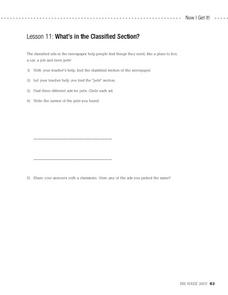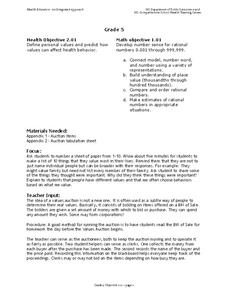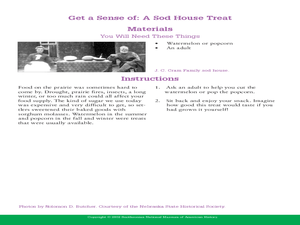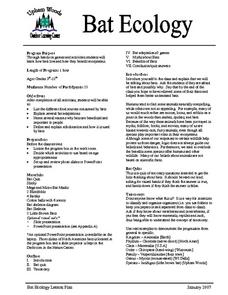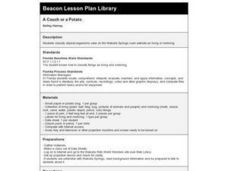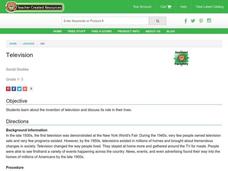Curated OER
What Do You Know About the Birds Around You?
Students compare and contrast various species of birds. After participating in a brief discussion of the characteristics of birds, they view birds in their natural habitat and in pictures with a focus on the similarities and differences...
Curated OER
Modern Living Made Easy
Students explore the history of the Industrial Revolution and how it preceded the development of many modern innovations. They research the history of many modern appliances and decide how they rely on these conveniences everyday.
Curated OER
What's Mongolia Really Like?
Learners look at rural Mongolian nomadic culture through the eyes of a Peace Corps Volunteer and examine the dynamics of a people in transition. They give one important reason for migration from a rural to an urban setting and explain...
Curated OER
Living History: Documenting Our Senior Citizens Lives
Students investigate stereotypes by researching the elderly. In this senior citizen lesson, students interview elders in a rest home and video tape their experience. Students present their videos to their interview subjects after and...
Curated OER
What Did I Just Read?
Students summarize a chapter from the book, "Sarah Plain and Tall. After reviewing the the formation of a topic sentence, they independently read a chapter from the book. Students write a summary paragraph using the checklist outlined by...
Curated OER
What's in the Classified Section
For this language arts worksheet, students discover the classified section of the newspaper. Students use a newspaper to find 3 different ads for pets and answer 5 questions.
Curated OER
Business: What Are Advertisers Selling?
Students will search for hidden messages in advertising and the "hidden audience." They gain a greater understanding of the structures of advetising and marketing.
World Wildlife Fund
Arctic Food Chain
Explore the food chains that support Arctic ecosystems. A class discussion on interdependence and the different roles plants and animals play in ecosystems provides students with the knowledge to complete a worksheet asking them to...
Ask a Biologist
It’s a Plankton Eat Plankton World
For as small as they are, plankton sure play an enormous role in maintaining marine ecosystems. Dive into an investigation of these tiny organisms with a hands-on life science activity in which children cut out pictures of sea animals...
NASA
Freshwater Availability Classroom Activity
This science assignment produced by NASA teaches inquiring minds the distribution of Earth's water. Learners will appreciate and understand the importance of fresh water and how weather and climate affects everything.
Biology Junction
Strawberry DNA
Humans eat around 93,205 miles of DNA in an average meal. Scholars learn how to extract DNA from a strawberry using a presentation. It walks through each step and explains why the process works. Comprehension questions encourage...
Curated OER
Agriculture Counts
Learners understand the importance of counting in their lives.In this counting lesson, students participate in a counting agricultural goods activity. Learners complete worksheets and understand why counting is important in agriculture.
Curated OER
My Brother Sam is Dead: A study of the Revolutionary War
Fifth graders complete an analysis of the Revolutionary War through literature. After "My Brother Sam Is Dead," students create a time capsule containing items that would be relevant during the Revolutionary War. They identify key...
Curated OER
Immigration Unit
Third graders develop an appreciate for the various cultures that are present in their local community. Through reading and research, they explain how various culture came to live in their area. At the conclusion of the unit, 3rd...
Curated OER
Quality of life for kids
Students explore the meaning of quality of life. Also, the need to prioritize means that government spending decisions are political, with winners and losers. Discussion platforms are on the six dimensions to a child's well-being:...
Curated OER
Agriculture Counts
Students discuss the kinds of things they count and how to use tally marks. In this social science lesson, students count animal crackers by using tally marks for each kind of animal. The tally marks are changed into numbers and one...
Curated OER
Values
Fifth graders participate in a class auction to determine their values. For this health and math lesson, 5th graders list the top ten most important things in their lives, then the teacher introduces the idea of a values auction....
Curated OER
Life in a Sod House: Get a Sense of It
In this history of Nebraska worksheet, students read information about pioneer life in a sod house. Students conduct 4 experiments where they use measurement skills and observational skills to imagine the size, light levels, smell of...
Curated OER
Science Fiction Stories
Students write a story. In this genre instructional activity, students read a science fiction story and discuss its characteristics. Students brainstorm a list of things that if scientifically changed would alter the way we live our...
Curated OER
Everyday Life in Africa
Learners read story Not So Fast Songololo by Niki Daly, compare life of a boy in Africa with their own lives, create sock puppets, and act out stories that they have written in groups.
Curated OER
Bat Ecology
Young scholars, through hands on games and activities, discover how bats live and how bats benefit ecosystems. They play a game designed to show them how echolocation works and another to show how mother bats locate their young through...
Curated OER
Advertise Your Family
In this periodic table worksheet, students create an advertisement for a chemical group or family they are assigned. They need to include topics such as are the elements solids, liquids or gases at room temperature, the history of the...
Curated OER
A Couch or a Potato
Learners classify objects and organisms seen on the Wakulla Springs icam website as living or nonliving.
Curated OER
Television
Students investigate the invention of television and examine its role in their lives. They read and discuss an informational handout, list the pros and cons of television on a worksheet, and create a class pie graph illustrating the...







